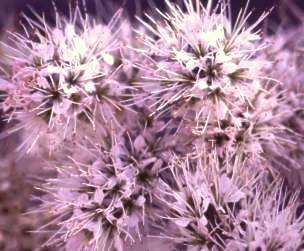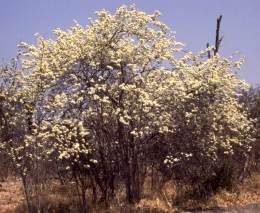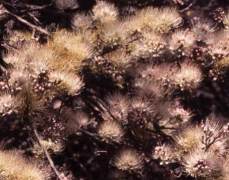Combretum mossambicense
Combretum mossambicense (Klotzsch) Engl.
Family: Combretaceae
Common names: knobbly creeper (Eng.); knoppiesklimop (Afr.)
SA Tree No: 545.1
Introduction
Masses of lovely fluffy pink-white flowers are displayed on bare branches in early spring. Fragrant and resembling small powder puffs, they lure a variety of pollinating insects.

Description
Description

The deciduous knobbly creeper has long trailing branches and usually easily scrambles into surrounding bush, where its flowers can be seen to advantage. However, it may also form either a shrub or small tree (3-4 m high, 3 m wide). Flowers appear from August to November (spring to summer), and are followed by five, or sometimes four, winged fruits that are tinged pink for a while before ripening to brown and papery in summer (October to January). The grey to brownish bark is smooth.
Distribution and habitat
Distribution description
This species is found in low-lying bushveld and thicket in hot, dry areas, on hills (koppies) and often near rivers in South Africa, Zimbabwe, Mozambique, Botswana, Namibia and northwards into the dry, hot parts of tropical Africa.
Derivation of name and historical aspects
History
Combretum is a name used by the Roman writer Pliny (23-79 A.D.) for a climbing plant, and mossambicense means 'from Mozambique'. There are 30 species of Combretum in South Africa. Most are trees or shrubs, but a few are scramblers (e.g. C. microphyllum and C. bracteosum). Several of the trees such as C. kraussii and C. erythrophyllum are also suitable for gardens.

Ecology
Ecology
Most browsers enjoy feeding on this Combretum, and the larvae of the striped policeman and Guinea-fowl butterflies feed on the leaves. The flowers draw insects, in turn attracting insect-eating birds such as the Brownheaded Kingfisher.
Uses
Use
Roots and leaves of C. mossambicense and Acalypha villicaulis are crushed and boiled in plenty of water. The extract is used to steam the face to reduce swelling caused by a tooth abscess, or for eye inflammation. Hot compresses are made from the dregs. The extract is also used for gargling or eye baths, or it is tossed onto red-hot coals and the steam is used to ease swollen body parts. The liquid can be rubbed into small scratches over swellings.
Growing Combretum mossambicense
Grow

Propagate it from seed or possibly from cuttings. It is suitable for gardens medium to large, especially in drier areas where water may be scarce. In the home garden it can either be pruned back heavily to discourage its climbing tendencies or, space permitting, it can be allowed to scramble up a dead tree, or to form a rambling shrub. Plant a group of these shrubs in a large shrub border, or train a plant up a trellis if space is limited. Train a plant over a pergola, where it can provide shade in summer, but some sun will filter through in winter.
Moderately fast-growing and fairly drought-resistant, the knobbly creeper prefers fertile well-drained soil that contains plenty of compost. Mulch well and replenish regularly. Once established, it won't need overly much water. It will probably produce a better flower display if it is kept reasonably dry in winter (do not let young newly planted shrubs dry out!).
Frost-hardy and relatively pest-free, it prefers a place in the sun and can tolerate temperatures ranging from about -4°C to 40°C (or higher?).
References
- Coates-Palgrave, K. 1988. Trees of southern Africa, edn 2. Struik, Cape Town.
- Joffe, P. 2001. Creative gardening with indigenous plants-a South African guide. Briza Publications, Pretoria.
- Palmer, E. & Pitman, N. 1972. Trees of southern Africa. Balkema, Cape Town.
- Pooley, E. 1993. The complete guide to trees of Natal, Zululand and Transkei. Natal Flora Publications Trust.
- Van Wyk, B. & Van Wyk, P. 1997. Field guide to the trees of southern Africa. Struik, Cape Town.
- Von Koenen, E. 1996. Medicinal, poisonous and edible plants in Namibia. Klaus Hess Publishers, Windhoek.
- Watt, J.M. & Breyer-Brandwijk, M.G. 1962. The medicinal and poisonous plants of southern and eastern Africa. Livingstone, London.
Credits
Pitta Joffe
Pretoria National Botanical Garden
August 2003
Plant Attributes:
Plant Type: Climber, Scrambler
SA Distribution: Limpopo, Mpumalanga
Soil type: Sandy, Loam
Flowering season: Spring, Early Summer
PH: Neutral
Flower colour: White, Pink
Aspect: Full Sun
Gardening skill: Easy
Special Features:
Horticultural zones








Rate this article
Article well written and informative
Rate this plant
Is this an interesting plant?
Login to add your Comment
Back to topNot registered yet? Click here to register.